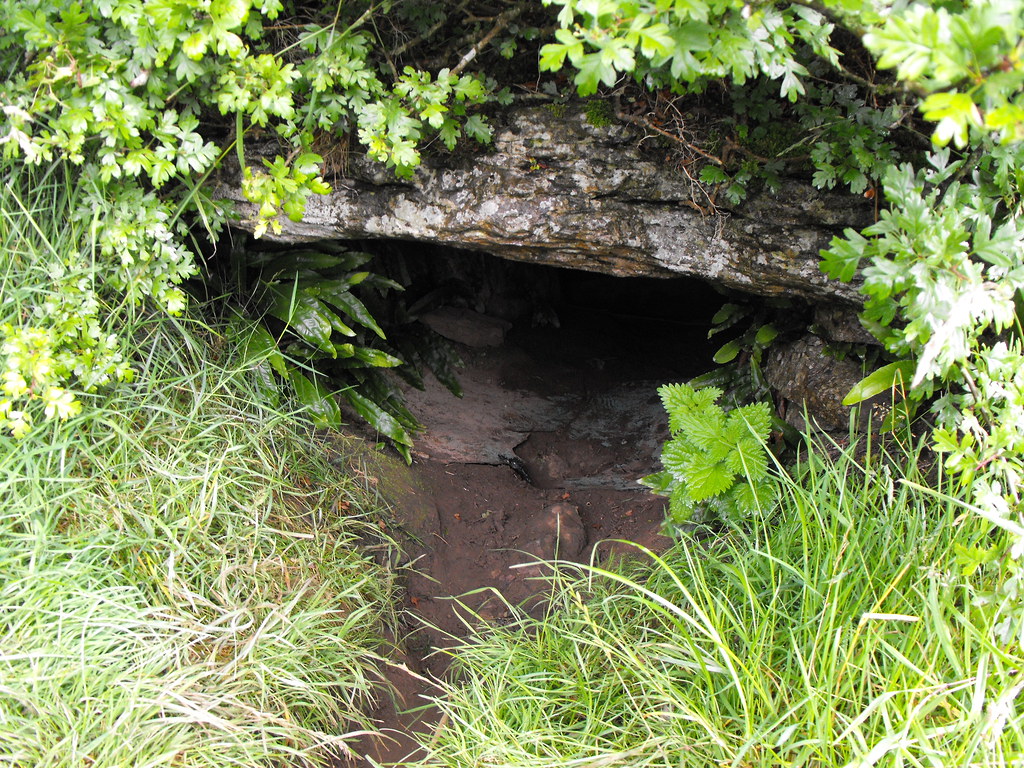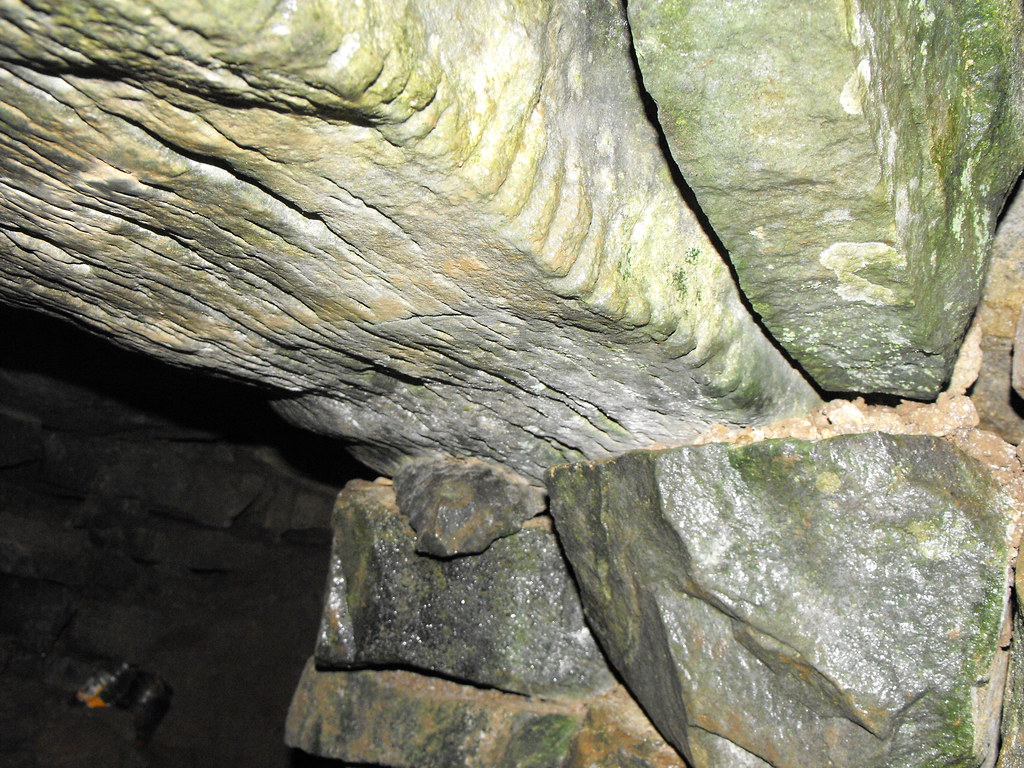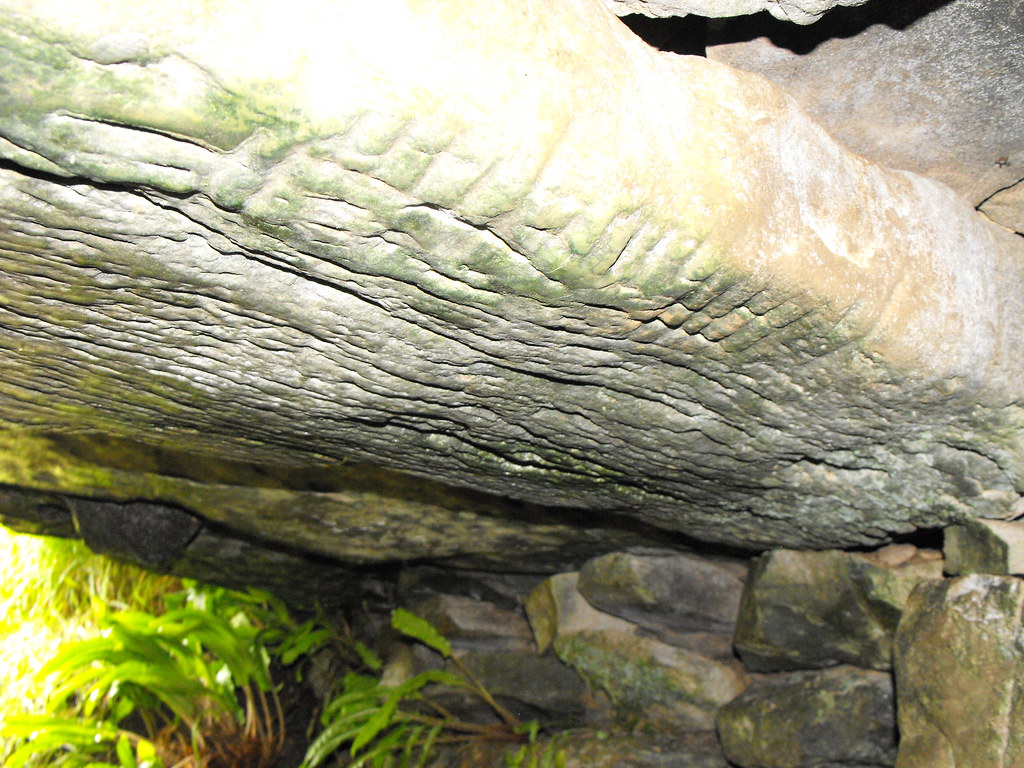Location – Driving from Rathnadarve away from the N5 take the next left and part at the end of the track. There is a gate on the right and the souterrain is in the bank and goes under the road.
OS: M 795 831 (map 33)
Longitude: 8° 18' 40.09" W
Latitude: 53° 47' 49.28" N
GPS: M 79584 83105 (Accuracy: 7m)
See map at the bottom of the page.
Description and History – This is one of the most interesting places I have been to in Ireland and it was quite an experience. Seated within a much destroyed earthwork is this well preserved souterrain which now has a 1930’s road running above it. There are two entrances to this souterrain although one is now partially collapsed and blocked up. The second entrance is quite large but still requires sliding into. Once inside you can sit up and move around somewhat. I’m not too comfortable with enclosed spaces but generally handle tombs and narrow passages well but this was different as it goes underground. Since I was with other people I decided to let the enthusiastic people go first and once they re-emerged and said how spacious it was I decided to go down. Unfortunately the people at the bottom still had the lamp so I only got half way down the passage before turning around. I didn’t fancy feeling my way around in the dark in a slippy souterrain. At the bottom of the passage (I will be going back to photograph the rest of it) the souterrain opens into a natural cave that it quite large and according to myth connects to the caves of Kesh in Co. Sligo. Graffiti left by Douglas Hyde, the First President of Ireland, can still be seen on the cave wall. In the entrance to the cave, ogham stones have been reused as lintels on the roof of the structure. It reads ‘VRAICCI...MAQI MEDVVI’ which translates as ‘the pillar of Fraech, son of Medb.’
OS: M 795 831 (map 33)
Longitude: 8° 18' 40.09" W
Latitude: 53° 47' 49.28" N
GPS: M 79584 83105 (Accuracy: 7m)
See map at the bottom of the page.
Description and History – This is one of the most interesting places I have been to in Ireland and it was quite an experience. Seated within a much destroyed earthwork is this well preserved souterrain which now has a 1930’s road running above it. There are two entrances to this souterrain although one is now partially collapsed and blocked up. The second entrance is quite large but still requires sliding into. Once inside you can sit up and move around somewhat. I’m not too comfortable with enclosed spaces but generally handle tombs and narrow passages well but this was different as it goes underground. Since I was with other people I decided to let the enthusiastic people go first and once they re-emerged and said how spacious it was I decided to go down. Unfortunately the people at the bottom still had the lamp so I only got half way down the passage before turning around. I didn’t fancy feeling my way around in the dark in a slippy souterrain. At the bottom of the passage (I will be going back to photograph the rest of it) the souterrain opens into a natural cave that it quite large and according to myth connects to the caves of Kesh in Co. Sligo. Graffiti left by Douglas Hyde, the First President of Ireland, can still be seen on the cave wall. In the entrance to the cave, ogham stones have been reused as lintels on the roof of the structure. It reads ‘VRAICCI...MAQI MEDVVI’ which translates as ‘the pillar of Fraech, son of Medb.’
Meaning the cave of the cats, Oweynagat was the home of the many mythological creatures in Irish mythology. The Ellen Trechen was a three headed monster that was said to have emerged from the cave and ravaged the countryside until it was killed by the hero Amergin. Red birds and pigs also emerged from the cave which caused anything they came in contact with to whither. The shape-shifting Morrigan is said to emerge from the cave every Samhain (Halloween). She is pulled on a chariot by a one legged chestnut horse and accompanied by other mythological creatures.
Difficulty – Easy enough to find but it naturally carries some dangers. The souterrain is slippy and muddy even in dry weather and it is easy to injure yourself in there. It is not for people who dislike enclosed spaces and I really wouldn’t recommend going in without someone waiting at the surface for you.
For more sites at the Rathcroghan complex, click here.
For more souterrains, click here.
For more ogham stones, click here.
For more sites in Co. Roscommon, click here.
Difficulty – Easy enough to find but it naturally carries some dangers. The souterrain is slippy and muddy even in dry weather and it is easy to injure yourself in there. It is not for people who dislike enclosed spaces and I really wouldn’t recommend going in without someone waiting at the surface for you.
For more sites at the Rathcroghan complex, click here.
For more souterrains, click here.
For more ogham stones, click here.
For more sites in Co. Roscommon, click here.
The main entrance.
The second and collapsed entrance.
Someone squeezing into the entrance so you can see that it actually bigger than it seems at first.
The Ogham inscription.
View The Standing Stone in a larger map







